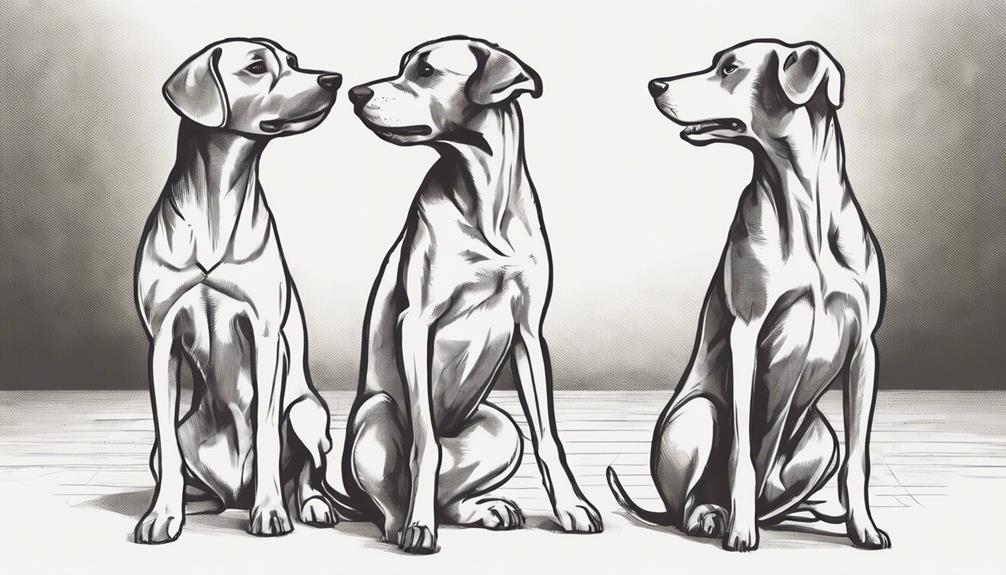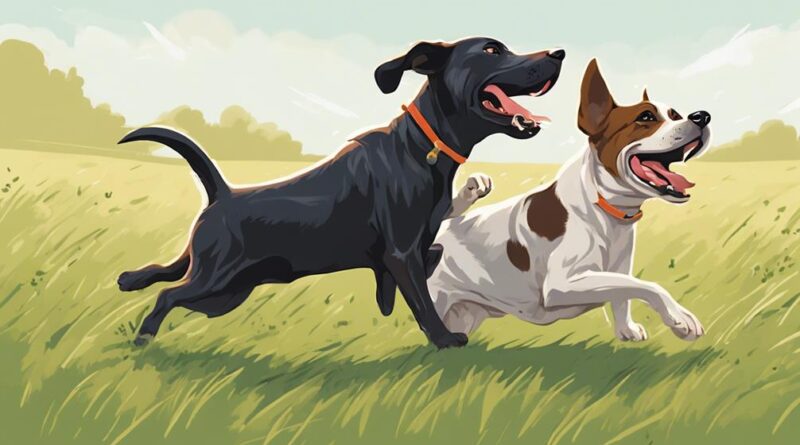14 Ways Dogs Socialize and Communicate With Peers
In the intricate world of canine interaction, dogs often speak volumes without uttering a single word. From wagging tails to subtle postures, they have a unique lexicon all their own.
However, did you know that there are fourteen distinct ways dogs socialize and communicate with their peers? Understanding these signals can provide a fascinating glimpse into the rich tapestry of canine communication.
Let's unravel these intriguing methods together.
Body Language
When observing your dog's behavior, pay close attention to their body language as it's a key indicator of their feelings and intentions. The position of their tail can convey a lot about how they're feeling. A tail held high typically indicates confidence or alertness, while a tucked tail suggests fear or submission. Wagging tails can show excitement or happiness, but it's essential to consider the speed and intensity of the wag as well.
Facial expressions are another crucial aspect of your dog's body language. Just like humans, dogs can use their faces to express a wide range of emotions. A relaxed face with soft eyes and a slightly open mouth often indicates a content and calm state. On the other hand, a tense face with narrowed eyes or bared teeth can signal aggression or discomfort. By paying attention to these subtle cues, you can better understand your dog's mood and respond accordingly.
Vocalizations
Pay attention to the various vocalizations your dog makes as they're an important form of communication that conveys different emotions and messages. Dogs use a range of vocal cues to express themselves, from barking behavior to howling expressions. Understanding these vocalizations can help you better comprehend your furry friend's feelings and needs.
Here are three ways in which dogs use vocalizations to communicate:
- Barking behavior: Dogs bark for various reasons, such as to alert you of potential danger, express excitement, or seek attention. The pitch, intensity, and frequency of their barks can convey different messages. Pay attention to these nuances to understand what your dog is trying to communicate.
- Howling expressions: Howling is a form of vocalization that can indicate loneliness, communication over long distances, or even a response to certain sounds like sirens. Dogs may howl to express their emotions or to join in a communal howling session with other dogs. Listen closely to the tone and context of their howls to interpret their meaning accurately.
Play Behavior
Engage with your dog in play behavior to strengthen your bond and provide mental and physical stimulation. Dogs exhibit various play styles, from gentle interactions to more rough and tumble sessions, each reflecting different social cues. By observing your dog's play style and responding appropriately, you can enhance your canine interactions and deepen your understanding of pack dynamics.
Play behavior serves as a crucial aspect of canine communication, allowing dogs to practice social skills, establish hierarchies, and release excess energy. Through play, dogs learn boundaries, practice give-and-take interactions, and strengthen social bonds within their pack or with human companions. Understanding your dog's preferred play style can help you cater to their needs and create a more enriching play experience.
Whether it's engaging in a game of fetch, tug-of-war, or simply romping around together, participating in play behavior with your dog fosters trust, reinforces positive behavior, and provides a healthy outlet for physical activity and mental stimulation. So, next time you interact with your furry friend, remember the importance of incorporating play to nurture your bond and promote your dog's well-being.
Scent Marking
Strengthen your understanding of your dog's communication by recognizing the significance of scent marking in their social interactions. Dogs use scent marking as a way to communicate with other animals, leaving behind pheromone trails that convey important information. By understanding how scent marking works, you can gain insight into your dog's behavior and interactions with their peers.
- Emotions: Scent marking can evoke feelings of security and comfort in your dog, helping them establish territorial boundaries.
- Connection: Through scent marking, dogs can connect with other animals in their environment, creating a sense of community.
- Identity: Scent marking allows dogs to leave behind a unique signature that identifies them to others, strengthening social bonds.
Tail Wagging
Dogs often communicate through tail wagging, a key indicator of their mood and emotions. Tail language insights reveal that the position, speed, and style of wagging can convey different messages. For example, a high and fast wag often signifies excitement or happiness, while a slow and low wag may indicate uncertainty or submissiveness. Understanding these wagging styles can help you interpret your furry friend's feelings accurately.
Pay attention to the context in which your dog is wagging its tail. A relaxed and loose wag when greeting someone familiar shows friendliness, while a stiff and rapid wag when encountering a stranger might signal alertness or caution. When playing, a broad and vigorous wag usually means joy and engagement in the activity.
Eye Contact
When observing your dog's behavior, pay attention to the significance of eye contact in understanding their communication cues and emotional state. Dogs use eye contact not only to communicate with humans but also with other dogs to establish social bonds and convey various messages. Here are a few key points to consider:
- Trust and Connection: Eye contact plays a crucial role in building trust and forming a strong emotional connection between dogs. When your dog looks into your eyes, it can signify affection, loyalty, and a sense of security.
- Dominance and Submission: In dog social interactions, prolonged eye contact can indicate dominance or aggression, while avoiding eye contact may signal submission or respect. Understanding these cues can help prevent conflicts during playtime or when meeting new dogs.
- Emotional State: The intensity and duration of eye contact can also reflect your dog's emotional state. For instance, dilated pupils may indicate excitement or fear, while soft, relaxed eyes often suggest contentment and relaxation.
Posture Signals

Pay close attention to your dog's body language as it communicates a wealth of information through posture signals. Posture signals play a crucial role in dogs' communication and social interactions. When dogs interact with peers, they often display various postures to convey their intentions and emotions. These postures can indicate where a dog stands in the dominance hierarchy within a group. A dog standing tall with their head held high may be asserting dominance, while a dog lowering their body and avoiding eye contact demonstrates submissive behavior.
Understanding posture signals is key to interpreting social cues between dogs. For instance, a dog rolling onto its back and exposing its belly is a sign of submission and a way to avoid conflict. On the other hand, a dog standing stiffly with a rigid body might be signaling dominance. By observing these posture signals, you can gain insights into how dogs interact and establish relationships with their peers.
Pheromone Communication
To further understand canine communication, it's essential to explore the fascinating realm of pheromone signals dogs use to convey information and establish connections with their surroundings. Dogs rely on chemical signals to communicate with their peers, providing a unique way to interact and form social bonds within their pack. These pheromones play a crucial role in shaping their social dynamics and relationships.
- Trust Building: Pheromones help dogs build trust with each other, creating a sense of security and comfort within their social group.
- Emotional Connection: Through these chemical signals, dogs can express their emotions and feelings, fostering a deeper emotional connection with their peers.
- Conflict Resolution: Pheromones also aid in resolving conflicts among dogs by signaling appeasement or submission, promoting harmony and cooperation within the pack.
Understanding the importance of chemical signals in canine communication sheds light on the intricate ways dogs socialize and maintain relationships with their peers.
Frequently Asked Questions
How Do Dogs Establish Dominance Within a Social Group?
When dogs establish dominance within a social group, they rely on various cues and behaviors to assert their position. Dominance dynamics play out through body language, vocalizations, and posturing during social interactions.
Dogs may use assertive displays such as standing tall, making direct eye contact, or engaging in physical interactions to establish their rank in the group. Understanding these cues is essential for interpreting the hierarchy within a dog social group.
What Role Does Age Play in How Dogs Interact With Each Other?
When dogs interact, age significantly influences their behavior. Younger dogs tend to engage in more playful interactions, helping them develop social skills and learn boundaries. Older dogs often take on the role of mentors, guiding younger peers through socialization. These age dynamics shape how dogs communicate and establish relationships within their social groups.
Play behavior plays a crucial role in fostering these social interactions, regardless of age.
Can Dogs Communicate Their Emotions Through Different Types of Body Language?
Yes, dogs can communicate their emotions through different types of body language cues. They use a variety of signals to express their feelings, such as wagging tails, raised hackles, and relaxed postures.
These emotional expressions help them convey joy, fear, aggression, or submission to other dogs and humans. Understanding these cues is essential for interpreting your furry friend's mood and responding appropriately to their needs.
Do Dogs Use Verbal Cues to Communicate With Each Other, or Is It Mostly Nonverbal?
Dogs primarily rely on nonverbal communication to interact with each other. They use various body language cues such as tail wagging, ear position, and facial expressions to convey their emotions and intentions.
While vocal cues like barking, growling, and whining can also play a role in communication, the bulk of their interactions are indeed nonverbal.
Understanding these nonverbal signals is crucial in deciphering how dogs socialize and communicate with their peers.
How Do Dogs Navigate Social Hierarchies Within a Group of Peers?
In a group of peers, dogs navigate social hierarchies through subtle behavioral cues and communication signals. They establish pack mentality by displaying dominant or submissive behaviors, which define their roles within the group.
Social dynamics among dogs involve body language, vocalizations, and posturing to maintain order and cohesion. By understanding these cues, dogs establish a structured hierarchy that helps them function effectively within their social group.
Conclusion
So next time you see dogs interacting with each other, pay attention to their body language, vocalizations, play behavior, scent marking, tail wagging, eye contact, posture signals, and pheromone communication.
By understanding these different ways dogs socialize and communicate with their peers, you can better interpret their behavior and strengthen your bond with your furry friends.
Don't forget to give them plenty of opportunities to socialize and communicate with other dogs to keep them happy and healthy.
